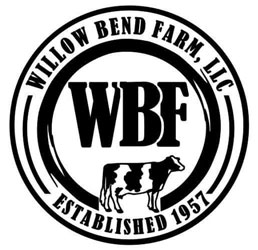The Beginnings
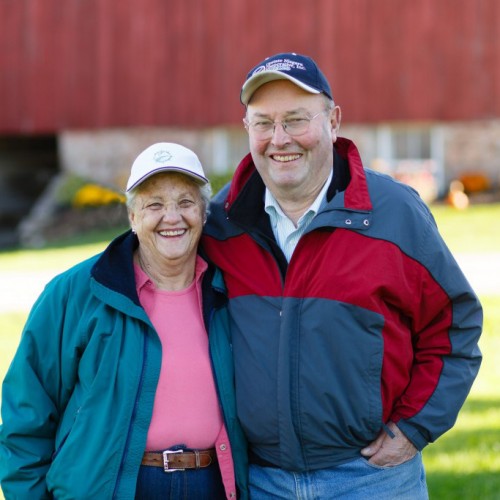
HOW WILLOW BEND BECAME A DAIRY FARM
By George Budd Mueller, 11/29/15
We have certainly had some good luck becoming dairy farmers. Having 80 heifers we could not sell gave us the volume we needed to compete in the industry. A silo blowing down got us started farming
with efficient bunker silos rather than inefficient tower silos. An uncle buying a farm in a strong agricultural area with good markets was a blessing over the stony and hilly Hudson Valley where my mother grew up.
We have been blessed with excellent employees over the years. We are very proud that some employees have gone out and now run their own farms.
Yes, we have had good fortune. But we also have worked hard when our friends had a lot more leisure time. We have plowed every extra penny we had back in the farm while our friends purchased boats, motor homes and
second homes on a lake. We have been frugal, hard working and lucky. We are delighted we were able to compete and become successful. As the sign over my desk says, “All we have we owe to UDDERS!” We sure have
had a lot of wonderful help along the way. This is the story of how the Budd and Mueller family made Willow Bend Farm into a dairy farm. Our present herd size of 3000 cows indicates there will be more stories to
come.
THE SMITH FAMILY LOSES WILLOW BEND FARM
For many generations, Willow Bend Farm was owned by the Smith family. Both Asa and Ervin Smith had attended Cornell in the late 1800’s. Sadly, a couple of barn fires and the “Great Depression” caused the Smith family to lose their farm to the Federal Land Bank in the 1930’s because of their failure to pay back the loans taken out to build back their barns. Many farms were lost during the depression, when you could not sell farm products to pay back farm loans.
WILLOW BEND’S FUTURE NOW IN THE HANDS OF THE BUDD FAMILY
In 1941, the Land Bank sold the farm to my uncle, Norval Budd, for $9,000. Norval was the manager of grain and bean marketing for GLF, a farm supply Co-op, and had a steady income when many a farmer
did not. Uncle Norval immediately made the large “Italianate” farm house with a cupola on top into a two family residence to save money. Part of the tenant’s rent was to milk the family cow, morning and night. That sweet
little Guernsey cow, with large easy milking teats, was the beginning of Willow Bend as a dairy farm.
Later, in 1943, Uncle Norval found a farmer and part time cattle dealer named Emmet Plyter, to live in the north half of the house and run the farm for 50% of the gross sales. Mr. Plyter raised corn, alfalfa hay, oats,
wheat, and red kidney beans. Occasionally, Mr. Plyter would purchase a small number of cows that had to be milked by hand until he could find a buyer for them. The milk was separated and the skim milk was fed to
the hogs. The sour cream (no refrigeration) was taken and sold to the Palmyra Creamery where they made rather good butter with it. That sour cream was the first dairy sold from Willow Bend.
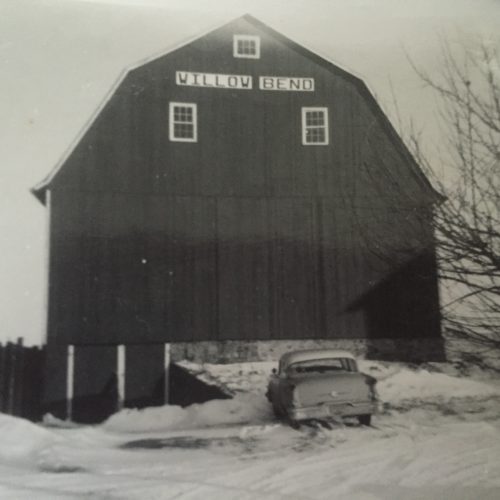
“That sweet little Guernsey cow, with large easy milking teats, was the beginning of Willow Bend as a dairy farm.”
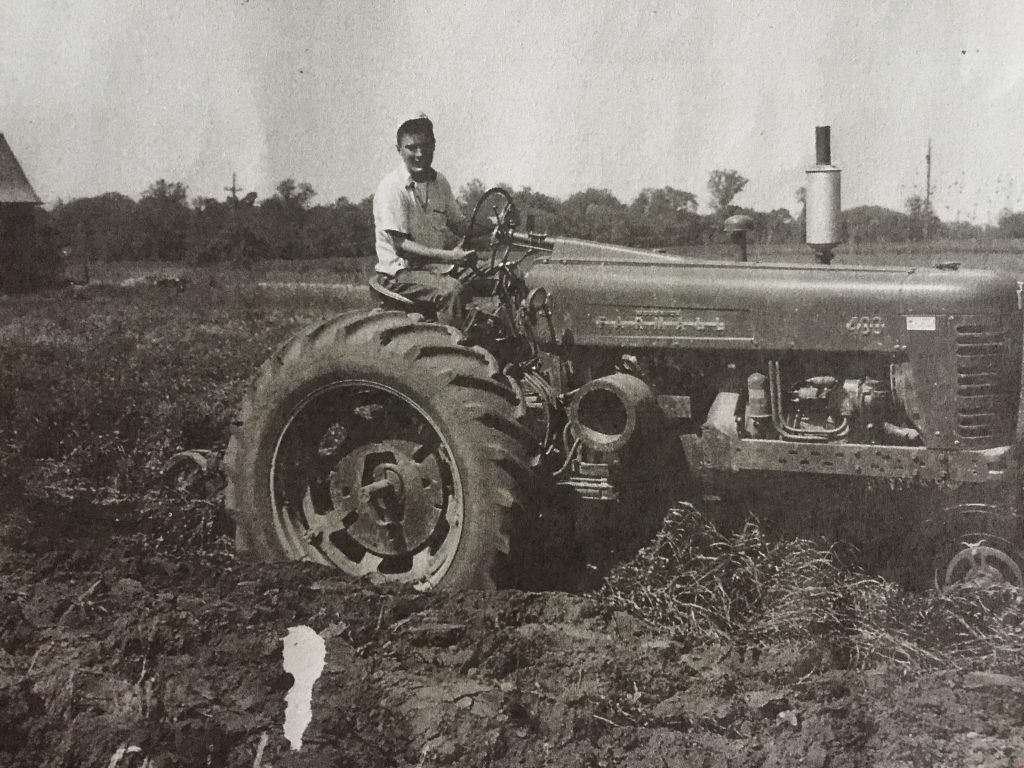
A CITY BOY GETS A TASTE OF FARMING...AND LIKES IT!
As a city boy, I would spend each summer with Uncle Norval and Aunt Peg while I was working for Mr. Plyter. My Uncle and Mr. Plyter were very good to me. Mr. Plyter would take me to cow auctions and on the way home
he would treat me to an ice cream cone. He taught me to run all his farm machinery. He taught me how to drive cars way before my city friends. Mr. Plyter only went as far as third grade, but was smart in the ways of the
world. He had purchased a farm just before the “Great Depression”. During the “Depression”, he could not make the payments, so he lost it to the bank. He swore he would never buy another farm again. He never did!
Mr. Plyter and I enjoyed listening to the “Lone Ranger” together on the radio. Mr. Plyter introduced me to farming…… and I loved it. Mrs. Plyter (Harriett) introduced me to homemade butter and elderberry pie, along
with many a hearty meal of meat and potatoes. She was a special lady.
Uncle Norval and Aunt Peg were equally as good to me and encouraged me to love farming. Every summer from 1943 through 1950, Aunt Peg fed me, did my laundry, and provided my bed. Uncle Norval would take me on
trips to the various GLF Co-op stores in western New York. As we traveled, he would point out the various methods of farming and how good the agriculture was in western New York. I give thanks each day that I am
farming in the best agricultural area of New York State. Uncle Norval liked ice cream cones also and that, too, convinced me that farming was a wonderful way of life. Uncle Norval and I would go to sleep listening
to my beloved Brooklyn Dodgers when they played at night. My summers were very special. I was blessed by those four people. I was also blessed by a mother who was a farmer’s daughter, and equally loved farming,
and sent me to her brother’s farm each summer.
“This is the story of how the Budd and Mueller family made Willow Bend Farm into a dairy Farm. Our present herd size of 3000 cows indicates there will be more stories to come.”
A CITY BOY COMPLETES HIS EDUCATION
Uncle Norval went to the Ag College at Cornell. Uncle Joe got a degree in electrical engineering from Cornell. Uncle Bob went to Cornell for civil engineering. I was accepted in the Ag. School. Uncle Norval
suggested I take R.O.T.C. and public speaking. Good advice……. and I did. Cornell kept me out of the Korean War, which erupted just as I was graduating from high school in 1950. R.O.T.C., and summer camp at
Fort Sill, Oklahoma in 1953, got me the rank of second lieutenant for my 16 month stay in peacetime Korea from 1955 to 1957.
Prior to Korea, I spent a year on the progressive dairy farm of my fraternity brother, Larry Smith, and his dad, Nelson (Lawnel Farms). That was my first real taste of dairy farming. We were milking
65 cows at the time, which was a large dairy back then. It was my first real taste of getting tractors stuck in the mud. When you only farm two months in the heart of the summer, you don’t experience
soil so wet that it has no bottom but I did at Lawnel! Nelson Smith was a former county agent and taught me a lot. I often quote him: “The eye of the owner fattens the calf.” “The footstep of the
owner is fertilizer for the soil”. The Smiths were very progressive and were experimenting with trench silos. I used the knowledge they gained with trench silos and applied it to bunker silos at
Willow Bend. Bunker silos have made us a lot of money at Willow Bend.
Again, I am indebted to a farmer’s wife, Rella Smith, for feeding me, doing my laundry, and providing a bed for me, from June of 1954 to April of 1955. The Smith family and their Lawnel Farms taught me a
tremendous amount about how to manage a dairy farm. They were an absolute key to my future success. Again, I was blessed.
“I give thanks each day that I am farming in the best agricultural area of New York State.”
THE ARMY SHOWED ME THE WORLD...May, 1955 to May, 1957
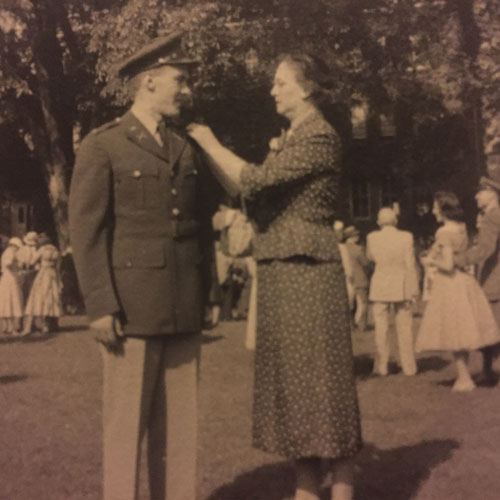
I saw how poor a nation is (Korea) after a devastating war. I saw how every acre of land was used to grow food. How hillsides were dammed up into little rice paddies, fed by mountain streams. They were structures that had to be made and maintained by hand. The rice in them had to be grown, weeded, and harvested by hand. On the way home, I took leave time to visit the agriculture of Japan, Philippines and Thailand. I soon realized how fortunate we were to have so much land in the United States and Western NY; and how precious land is, and how it must be taken care of for future generations. The Army was a key part of my education. I was discharged from the Army in May of 1957. Now it was time to try farming as a life’s work. It was time to look up that girl that had been sending me the Rice Krispie Cookies in Korea.
PREPARING FOR A LIFE OF FARMING
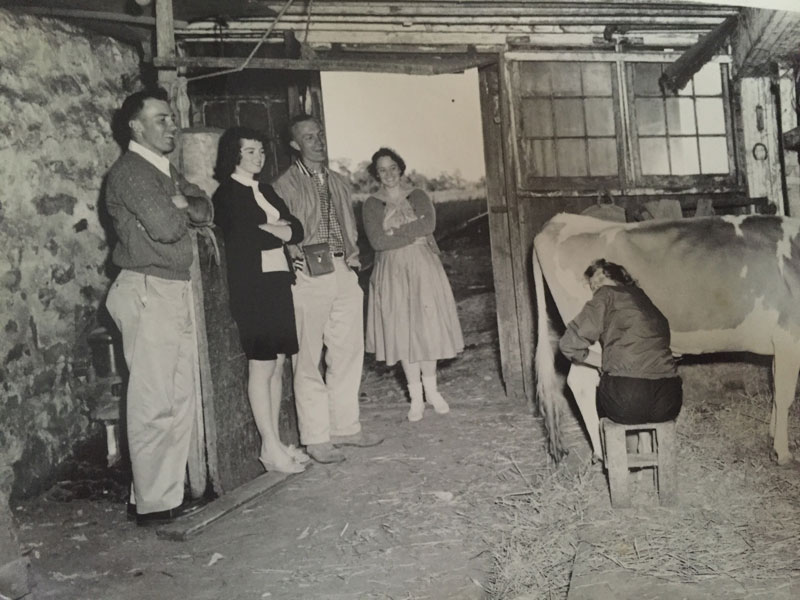
It was time to settle down and tackle the three things I thought I was put on this earth for:
- Find a good spouse to spend the rest of my life with.
- If blessed with children, do the best possible job preparing them for life.
- Find an occupation I love that provides the income necessary to raise the family.
“I soon realized how fortunate we were to have so much land in the United States and Western NY; and how precious land is, and how it must be taken care of for future generations.”
A PARTNER ON A FARM
In 1957, Mr. Plyter was 72 years old and had some heart problems. He wanted to slow down. He had taught me to love farming and we got along well. So both he, and Uncle Norval, took me into the partnership. Instead
of splitting the gross receipts 50/50 they would now split the proceeds 2/5 for Uncle Norval for supplying the land, seed and fertilizer. 2/5 went to Mr. Plyter for supplying the labor, machinery, fuel and know-how.
1/5 went to me for supplying the ambition and muscle. Although even at age 72 Mr. Plyter had a lot more strength and muscle than I ever have had.
The summer went well, but because of my ambition and inexperienced suggestions based on college ideas, Mr. Plyter and I no longer had the warm fuzzy relationship of my growing up years. At the end of
the year, Mr. Plyter with his heart condition, to quit active farming. Social Security was just coming in for self-employed farmers and he would benefit after contributing for only a few years. He offered
to sell me his complete line of machinery for $9250, (A motor job on a tractor costs more than that today). It was a good line. It included the single axle truck for grain or cattle that was almost new and the
IHC Farmall 400 tractor that was almost new. He had a four row corn planter when the neighbors all had two row planters. He had a Case combine. He had another Farmall M tractor and a full line of tillage and hay
equipment, including two buck rakes. All for $9250.
PLYTER HAD SECOND THOUGHTS
Mr. Plyter was going to hold back a mortgage that would give him a steady income and earn some interest besides. But over-night, he got to thinking, “That equipment is my life’s savings and I am depending on a city boy to pay me back. What if he ruins the equipment and fails to make his payments?” So the next morning, he said he would sell me the complete line for $500 less ($8750) if I would get a loan from a bank. Uncle Norval agreed to co-sign for me at Lincoln First Bank. But “The Farmers Home Administration” of the U. S. Dept. of Agriculture would give me a loan under their “starting young farmers program” at only 5% interest with no co-signer. Whereas Lincoln First required a co-signer and was at 6% interest (The state law usury maximum rate at the time). I chose to go with the Farmers Home Administration and their cheaper rate.
“On the way, I stopped at Syracuse University to visit the farmer’s daughter that had been sending me the Rice Krispie Cookies in Korea. She gave me a big hug and we were married two years later (May 9th 1959). If you are going to be a farmer, marrying a farmer’s daughter is not that bad an idea. They know how hard their mother worked and what they are in for.”
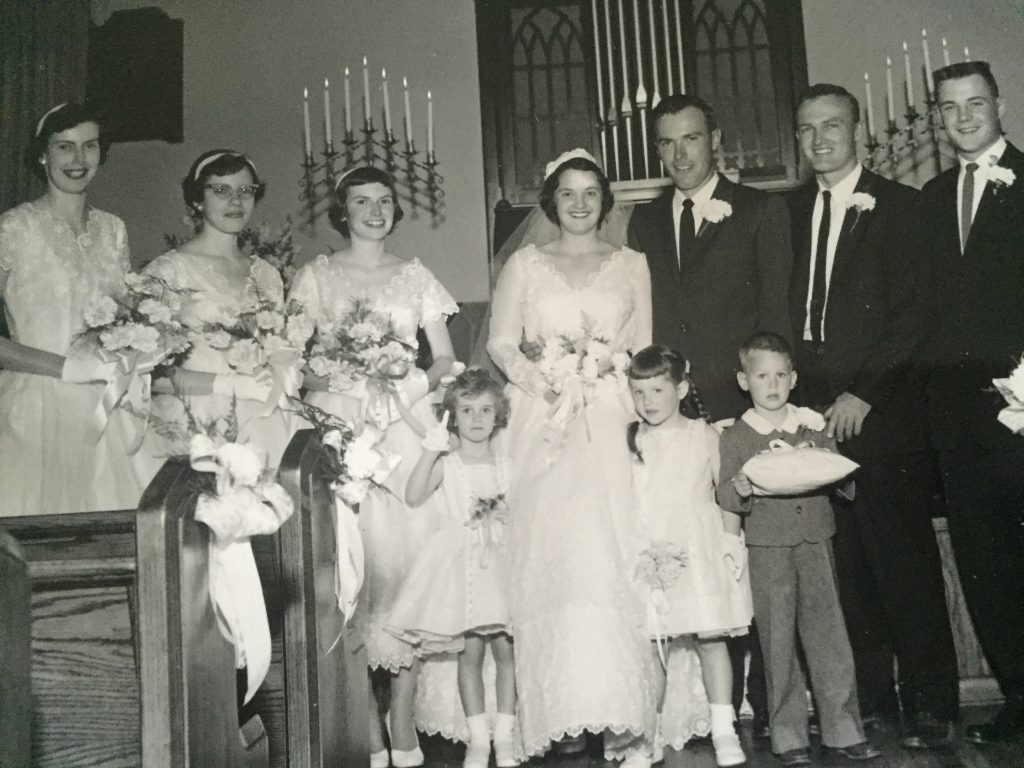
BILL WEBSTER AND THE FARMERS HOME ADMINISTRATION
A beginning farmer loan from FHA came with supervised credit. Bill Webster, who lived in Seneca Castle, would visit the farm twice a year to see how we were doing. FHA had a green account book that we were required to
keep our expenses and income in. I was always thinking of what enterprises I should try. I tried hogs for awhile and found out the mother sows were clumsy and killed some of their new borns by laying on them. I also found
out that pigs could be perfectly healthy in the morning and dead at night. Cattle, at least let you know they do not feel well before they up and die. I decided against hogs.
My future father in law, Ralph Morgan, had done very well with 3000 chickens (layers) after World War II. I believed my beautiful hip roof barns could be converted into poultry housing for 6000 birds or more.
My neighbor down the road, Alden Payne, had 3000 layers and was doing very well selling on the Rochester market.
Bill Webster stopped by one day and I mentioned how my barns would convert nicely into poultry housing. The huge frown on my banker’s face indicated to me that he was not in love with my idea. I dropped the idea. I owe Bill Webster a lot. Where would I be today with an obsolete poultry house when the big boys need houses of a million or more birds to compete.
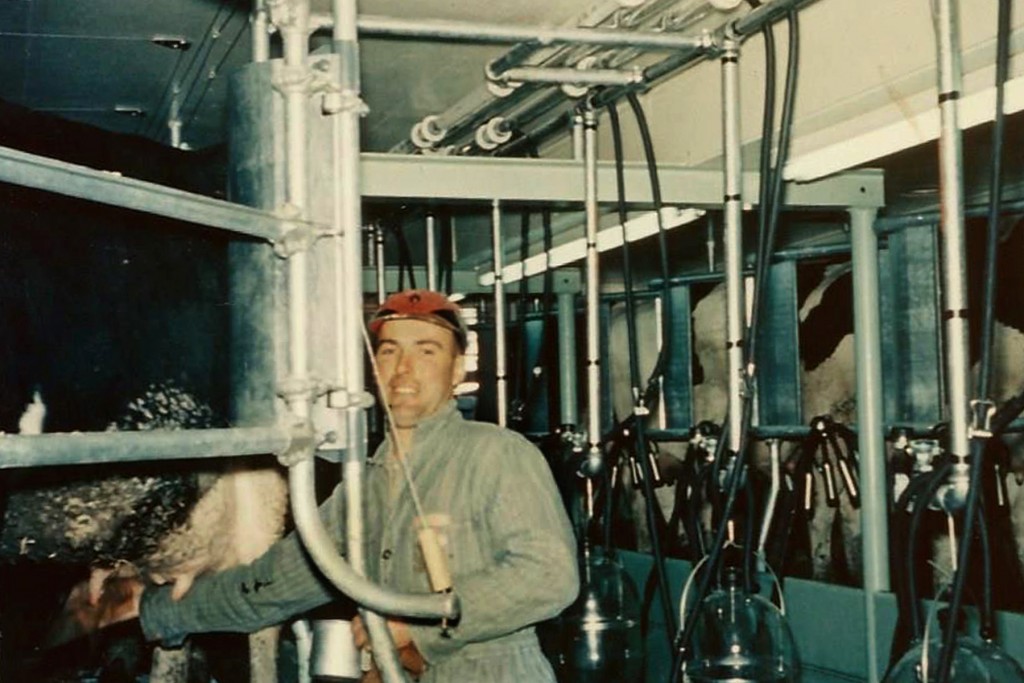
“I had been thinking about becoming a dairy farmer all my life. My high school yearbook says my goal was to own a 500 acre farm with 50 cows.”
MAKING LEMONADE OUT OF A LEMON
I mentioned that bunker silos have made us a lot of money. They are very easy to fill and to get the silage out of. When a herd reaches more than 150 cows, the well known round tower silos are terribly slow and
obsolete. Let me tell you how we were one of the first farms in Ontario County to have a bunker silo.
Back in 1958, I was just starting out on my own with Mr. Plyter’s full line of equipment. In early June, a hurricane, named Audrey, came by and gave us some pretty high winds. I went out the next
morning and found our empty round wooden tower silo flat on the ground with boards and silo hoops laying everywhere. I thought it was terribly bad luck for a farmer just starting out, but it turned
out to be very good luck instead. It gave us a head start in building efficient bunker silos for our farm. We needed that silo to feed sweet corn waste silage to our heifers all winter long. We
needed a new silo by late summer. What could we do?
I had experience at Lawnel with trench silos. I had been reading about bunker silos which were the same as a trench silo except bunker silos were above ground. We decided to build a bunker silo
next to the basement wall of our milking barn. There was a “Koppers Poles” depot at the Manchester RR yard and I went and got some poles for our bunker silo. We put a row of poles parallel to the
basement wall and 15 feet away. Next, my cousin, Bill Budd, and I used a small electric concrete mixer to mix concrete for a floor. The gravel we used came from Fran Bremer’s gravel pit that was next
to our farm. It was very clean gravel and did not need washing. It was slow progress. We could only pour 10 feet by 15 feet each day. However it turned out to be some of the best concrete on the farm.
We ended up with a silo 15 feet wide and 60 feet long. The silo boards from the old wooden silo were used for the outside wall and nailed to the poles. The silo hoops were straightened and then cut into
five foot lengths and used for electric fence posts. Like the slaughter house we used everything except the squeal. The small bunker silo was used at Willow Bend for many years. I think it was one of the
first bunker silos in Ontario County. The lemonade from our broken silo turned out to be pretty good!
SEARCHING FOR A TYPE OF FARMING TO SPECIALIZE ON
So I was off and running on my own. I had a full line of machinery and hired some of the neighbor boys as part time help. We raised corn, wheat, oats, alfalfa hay, red kidney beans, and green (snap) beans. Under t
he large hip roof barns we raised yearling heifers to sell just before they freshened (Just before they had their calf). We would purchase yearling heifers, and a bull to put with them, so they would freshen a year after
we purchased them. We would pay about $150 for yearlings and sell them for $300 just before they had their first calf and make a nice profit for a year of work and feed. The first year (winter of 57-58) we had 40 heifers
and did well. The second year we had done so well we purchased 80 heifers and again did well receiving $300 for the heifers as they got close to having a calf. The third year (winter of 59-60) we again had 80 heifers and
when it came time to sell them…………nobody wanted them. There was a huge surplus of milk in 1960. The best we could get for them was $150 and that was what we had paid for them. Being a Cornell graduate I knew that was not
a profitable situation. I had been thinking about becoming a dairy farmer all my life. My high school yearbook says my goal was to own a 500 acre farm with 50 cows. That winter, one stormy Christmas day I had been
visiting the Morgans and snuck out to visit Don Irving. He was a good college fraternity brother who was trying to get started as a dairy farmer. He had rented a farm from the Gratwick Family next door. I was very
impressed, as the wind howled outside with, how comfortable and cozy his herd of 40 cows seemed to be in the warm cow stable.
It was a choice of becoming a snap bean grower or milking cows. Fortunately I did not choose snap beans. During the early 60’s, we had a drought and I would have been out of farming in three years
if I had chosen snap beans. The beauty of dairy farming is you have a milk check every month in spite of drought or floods. The stability of dairy farming was very attractive.
I talked it over with my uncle Norval. We had 80 heifers we could not sell. It would take my uncle two or three months to have a milk house built for $5000, run the electric for $1000, and pour some
concrete in the barnyard for $2000. I had to purchase a bulk tank for $3600, four used milking machines at $30 each, and two used vacuum pumps for $30 each. We could milk the first heifers that
freshened in a neighbor’s barn (that sat idle) while we built our facilities at Willow Bend. Thus, for a capital investment of less than $12,000 we could have an 80 cow milking herd up and running
when all the neighbors were milking 15, 30, or 50 cows.
After much serious discussion, my uncle and I decided to become dairy farmers. Since there was a lot more work with milking cows we agreed that 5/8 of the milk check should go to me and 3/8 to my
Uncle Norval. Of course there is a lot more revenue when you milk cows rather than just sell them. After much hard work getting the neighbor’s barn and pastures ready to milk cows in, we moved our
heifers up there as they had their calves. At the same time, we were building at home. Finally, we were ready at home. We rounded up all the neighbor’s kids and had a cattle drive down County
Road #7 to our brand new dairy farm.
We milked in nine wooden stantions that a previous owner had installed hoping to earn enough to pay the mortgage. We would milk four while we chased four out and brought four new cows in. We walked
through a hole in the stable wall into the milk house where we dumped directly from the milker unit pail into the bulk tank. No need to transfer the milk to a carrying pail. Today, we would, call
such a set-up a “flat barn parlor” Actually, we may have had the first “flat barn parlor” in Ontario County.
Our higher volume was one secret to our success. In 1960, there were 33 farms shipping milk in the Town of Manchester from their small dairies. There were a total of 960 cows, giving Manchester
an average of 29 cows per farm. Today, there are only three dairy farms remaining in Manchester (including Willow Bend) but these three own over 2500 cows and produce almost three times as much milk,
per cow, as in 1960. The change in dairy farming has been remarkable these last 56 years.
“We have certainly had some good luck becoming dairy farmers.”
